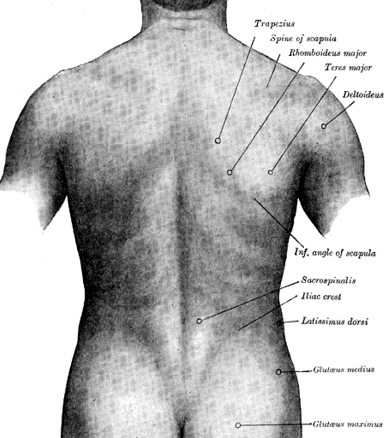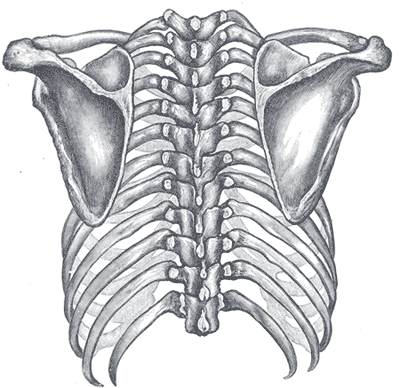Human back
Editor-In-Chief: C. Michael Gibson, M.S., M.D. [1]

The human back is the large posterior area of the human body, rising from the top of the buttocks to the back of the neck and the shoulders. It is the surface opposite to the chest, its height being defined by the vertebral column (commonly referred to as the spine or backbone) and its breadth being supported by the ribcage and shoulders. The spinal canal runs through the spine and provides nerves to the rest of the body.
Anatomy of the back
Skeletal structure of the back

The central feature of the human back is the vertebral column, specifically the length from the top of the thoracic vertebrae to the bottom of the lumbar vertebrae, which houses the spinal cord in its spinal canal, and which generally has some curvature that gives shape to the back. The ribcage extends from the spine at the top of the back (with the top of the ribcage corresponding to the T1 vertebra), more than halfway down the length of the back, leaving an area with less protection between the bottom of the ribcage and the hips. The width of the back at the top is defined by the scapula, the broad, flat bones of the shoulders.
Muscles of the back
The spine is bordered by several groups of muscles, including the intertransversarii muscle which facilitate movement between the individual vertabrae, and the multifidus spinae, which facilitate the movement of the spine as a whole.
Other muscles in the back are associated with the movement of the neck and shoulders. The trapezius muscle, which is named from its trapezium-like shape, runs between the neck, the anterior chain, the two shoulders, and the thoracic vertebra, T12. The large latissimus dorsi make a triangle from the shoulder to the hip. The significant mass of muscles in the back can be developed through back exercises.
Function of the back
The intricate anatomy of the back is designed to both provide support for the head and trunk of the body, strength in the trunk of the body, as well as a great deal of flexibility and movement. The upper back has the most structural support, with the ribs attached firmly to each level of the thoracic spine and very limited movement. The lower back allows for flexibility and movement in all directions.
Back pain
The back comprises interconnecting nerves, bones, muscles, ligaments and tendons, all of which can be a source of pain. Back pain is one of the most common types of pain in adults. By far the most common cause of back pain is muscle strain. The back muscles can usually heal themselves within a couple of weeks, but the pain can be intense and debilitating. Other common sources of back pain include disc problems, such as degenerative disc disease or a lumbar disc herniation, many types of fractures, such as spondylolisthesis or an osteoporotic fracture, or osteoarthritis [2].
Organs of the back
The lungs are within the ribcage, and extend to the back of the ribcage, making it possible for them to be listened into through the back. The kidneys are situated beneath the muscles in the area below the end of the ribcage, loosely connected to the peritoneum. A strike to the lower back can damage the kidneys of the person being hit.
Surface of the back
The skin of the human back is thicker and has fewer nerve endings than the skin on any other part of the torso. With some notable exceptions (see, e.g. George "The Animal" Steele), it tends to have less hair than the chest on men. The upper-middle back is also the one area of the body which a typical human under normal conditions might be unable to physically touch. When this area is itchy, a backscratcher can be used to ease the discomfort.
Significance in human society
The curvature of the female back is a frequent theme in paintings, because the sensibilities of many cultures permit the back to be shown nude - implying full nudity without actually displaying it. Indeed, the practice of showing explicitness on the lower back has been performed for centuries. Certain articles of clothing, such as the haltertop and the backless dress, are designed to expose the back in this manner. The back also serves as the largest canvas for body art on the human body. Because of its size and the relative lack of hair, the back presents an ideal canvas on the human body for Lower back tattoos. Indeed, some individuals have tattoos that cover the entirety of the back. Others have smaller tattoos at significant locations, such as the shoulder blade or the bottom of the back.
Many English idioms mention the back, usually highlighting it as an area of vulnerability; one must "watch one's back", or one may end up "with one's back up against the wall"; worse yet, someone may "stab one in the back", but hopefully a friend "has got one's back". The back is also a symbol of strength and hard work, with those seeking physical labor looking for "strong backs", and workers being implored to "put their back into it".
References
ar:ظهر pdc:Buckel de:Rücken eo:Dorso he:גב nl:Rug (anatomie) fi:Selkä sv:Rygg yi:רוקען